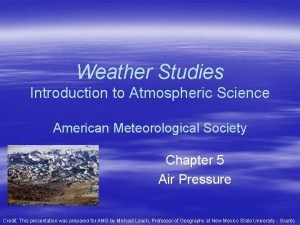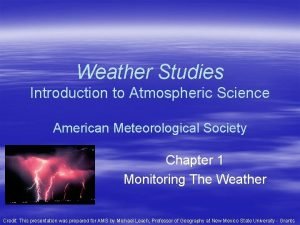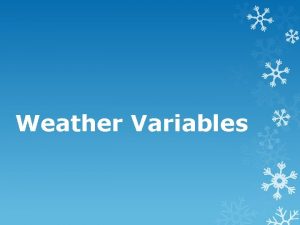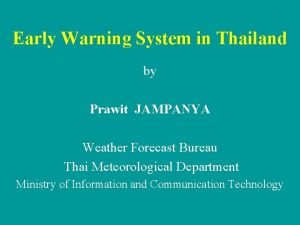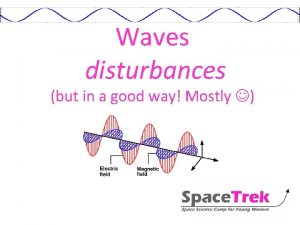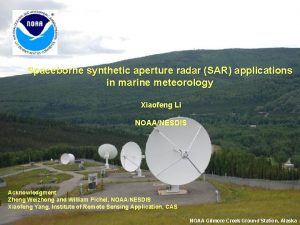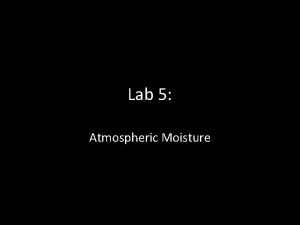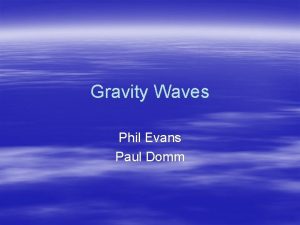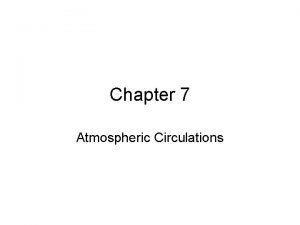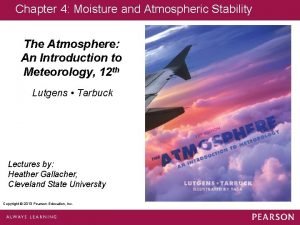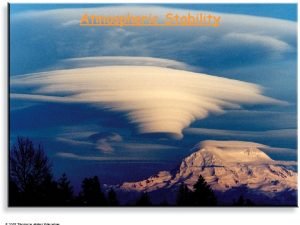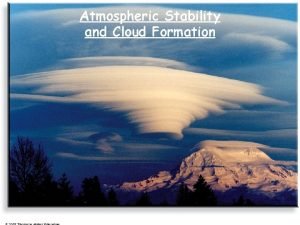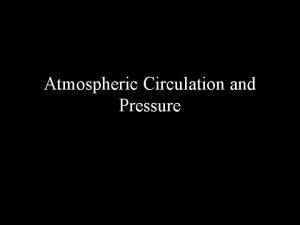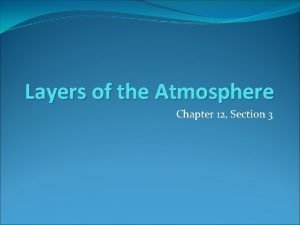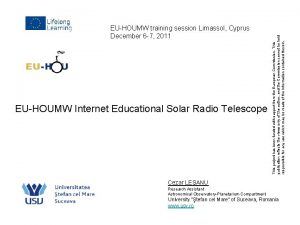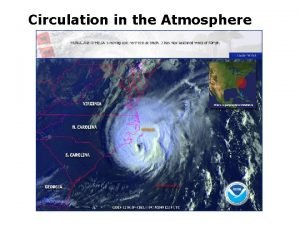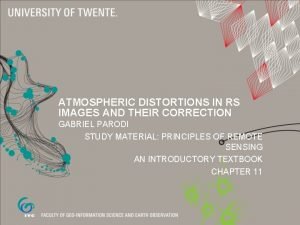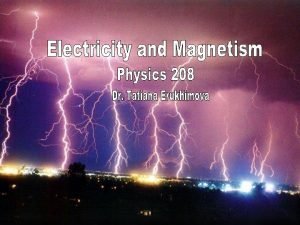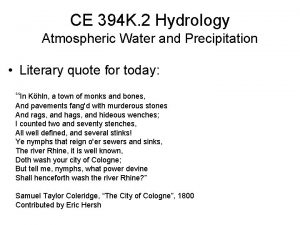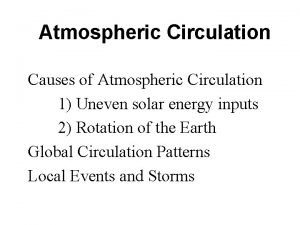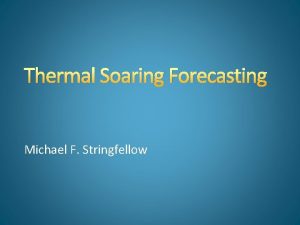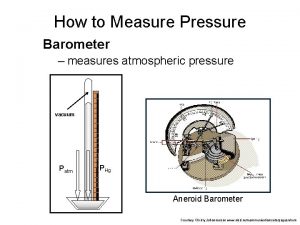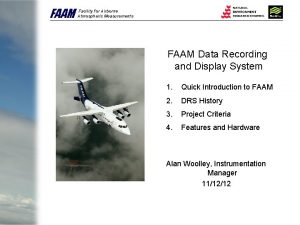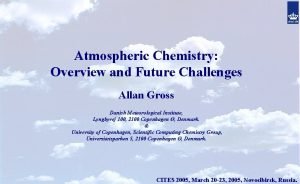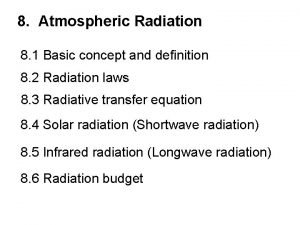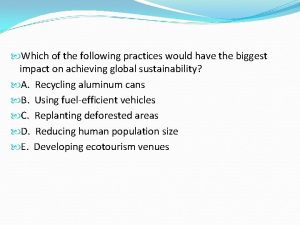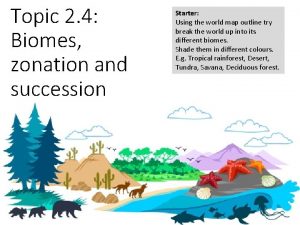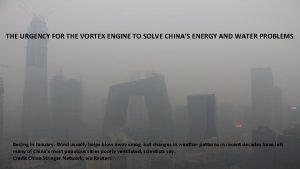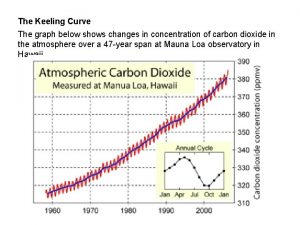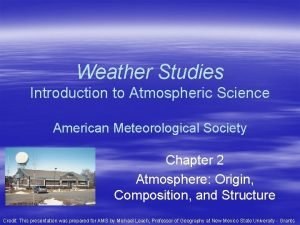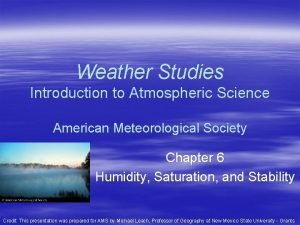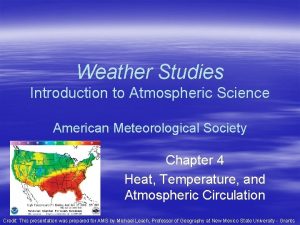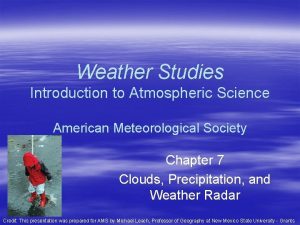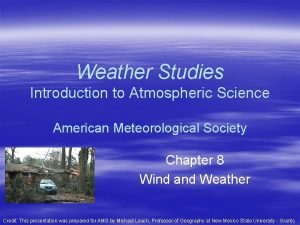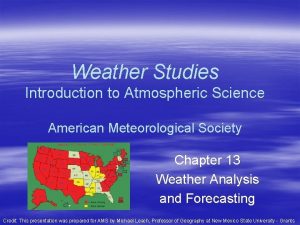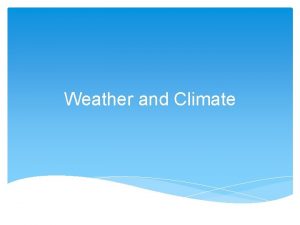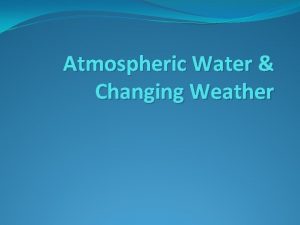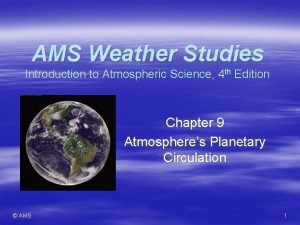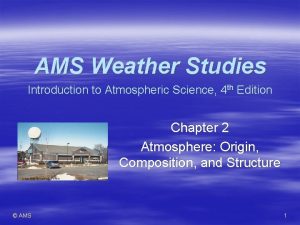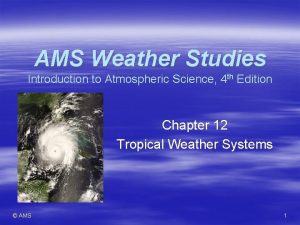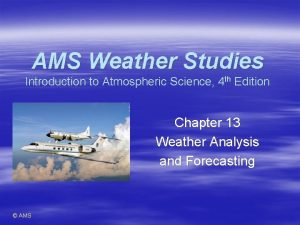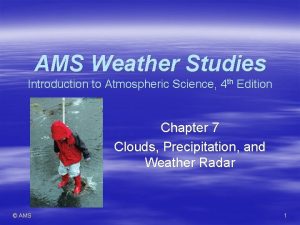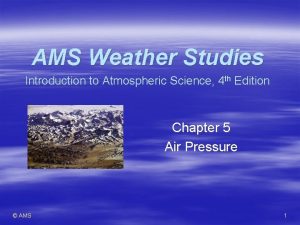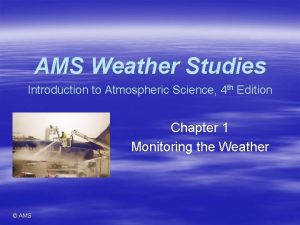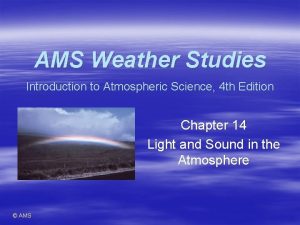Weather Studies Introduction to Atmospheric Science American Meteorological

























































- Slides: 57

Weather Studies Introduction to Atmospheric Science American Meteorological Society Chapter 9 Atmosphere’s Planetary Circulation Credit: This presentation was prepared for AMS by Michael Leach, Professor of Geography at New Mexico State University - Grants

Case-in-Point § 1983 was a year of wild weather – There were 2000 weather–related deaths – $13 billion in weather-related property damage – There were floods, droughts, and fires worldwide § Just prior to these weather extremes, the ocean circulation off the northwest coast of South America changed drastically – Off the coast of Ecuador, the quantity of plankton decreased 20 -fold § This reduced the number of anchovy § Fish that fed on anchovy declined markedly § Commercial fisheries off the coast of Ecuador and Peru collapsed – On Christmas Island, where ~17 million seabirds normally nest, most adult birds abandoned their nesting grounds for sites with more food, leaving their young to starve § All of this was driven by large-scale atmosphere/ocean circulation changes attributed to El Niño 2

Driving Question § What are the principal features of the planetary-scale atmospheric circulation, and how does the circulation affect weather and climate? § This chapter describes planetary-scale: – Pressure systems – Wind belts – Circulation patterns of middle latitude westerlies – Anomalous variations in the circulation regime that result in El Niño and La Niña 3

Idealized Circulation Pattern § To start with, assume a non-rotating Earth § Also assume a uniform solid surface § Sun heats the equatorial regions more intensely than the poles; a temperature gradient develops § Convection cell forms when cold, dense air sinks at the poles and flows at the surface toward the equator, where it forces warm, less dense air to rise. Aloft, equatorial air flows toward the poles. 4

Idealized Circulation Pattern § If the idealized planet starts to rotate from west to east, the Coriolis Effect comes into play § Northern Hemisphere surface winds are diverted to the right and blow toward the southwest § Southern Hemisphere surface winds are diverted to the left and blow toward the northwest § Winds blow counter to planet’s direction of rotation 5

Idealized Circulation Pattern § Circulation is maintained in the atmosphere of our idealized Earth because the planetary-scale winds split into 3 belts in each hemisphere § 3 belts are: – – – 0° to 30° to 60° to 90° § Now some winds blow with and some blow against the planet’s rotation 6

Idealized Circulation Pattern § Surface winds converge along the equator and along 60° latitude circles – Convergence leads to rising air, expansional cooling, cloud development and precipitation – Convergence zones are belts of relatively low surface air pressure § Surface winds diverge at the poles and along the 30° latitude circles – Air descends, is compressed and warms, and weather is generally fair – Divergence zones are belts of relatively high surface air pressure 7

Features of the Planetary-Scale Circulation § Adding continents and ocean basins complicates the picture § Some pressure belts break into separate cells § Important pressure contrasts develop over land versus sea § Maps show mean sealevel air pressure during January (top) and July (bottom); these are semipermanent features 8

Features of the Planetary-Scale Circulation § Schematic representation of the planetary-scale surface circulation of the atmosphere 9

Features of the Planetary-Scale Circulation § Pressure Systems and Wind Belts – Subtropical anticyclones § Form near 30° N and S latitude over oceans § Extend from the ocean surface to the tropopause and exert a major influence on weather and climate over vast areas of the ocean and continents § Subsiding air extends outward from the eastern sides – Compressional warming, low relative humidity, and fair skies are common – Major deserts are located on eastern flanks § The far western portions are characterized by less subsidence, less stable air, and frequent episodes of cloudy, stormy weather 10

Features of the Planetary-Scale Circulation § Pressure Systems and Wind Belts, cont. – Subtropical anticyclones § Common is a weak horizontal pressure gradient over a large area – Winds are weak and – Horse latitudes (30 to 35 degrees N and S) result § Surface winds poleward of the horse latitudes are the midlatitude westerlies § Winds blowing out of the high pressure cells toward the equatorial lows are called the trade winds § Trade winds from the two hemispheres converge into a broad eastwest equatorial belt of light and variable winds called the doldrums. In that belt, ascending air induces cloudiness and rainfall and the most active weather develops along the intertropical convergence zone (ITCZ). 11

Features of the Planetary-Scale Circulation § Pressure Systems and Wind Belts, cont. – Poleward of subtropical anticyclones: § Surface westerlies flow into regions of low pressure § These are the Aleutian low and the Icelandic low in the Northern Hemisphere § In the Southern Hemisphere, this is a nearly continuous belt of low pressure surrounding Antarctica § Surface westerlies meet and override the polar easterlies along the polar front – In places where the polar front is well-defined, it is a potential site for development of extra-tropical cyclones – Polar highs are shallow, cold anticyclones that develop at high latitudes 12

Features of the Planetary-Scale Circulation § Winds Aloft – Aloft, winds in the middle and upper troposphere blow away from the ITCZ – These feed into the subtropical highs – Resulting convection cells are called Hadley cells 13

Features of the Planetary-Scale Circulation § Winds Aloft, continued – Aloft in middle latitudes, winds blow from west to east in a wavelike pattern of ridges and troughs – These winds are responsible for the movement of the synopticscale weather systems – Their north/south components contribute to poleward heat transport 14

Vertical Cross Section of Prevailing Winds in the Troposphere The altitude of the tropopause is directly related to the mean air temperature of the troposphere. The tropopause is found in three segments, occurring at highest altitudes in the tropics and lowest altitudes in the polar regions. 15

Features of the Planetary-Scale Circulation § Trade Wind Inversion – A persistent and climatically significant feature of the planetary-scale circulation over the eastern portions of tropical ocean basins – Key to formation is the descending branch of the Hadley cell – Descending air is warmed by compression and its relative humidity decreases – This air encounters the marine air layer overlying the ocean surface § Where SST are low, layer is cool, humid, and stable § Where SST are high, layer is warm, more humid, less stable, and well mixed by convection – The trade wind inversion is formed at the altitude where air subsiding from above meets the top of the marine layer, trapping the cool marine layer near the surface § Develops to the east and southeast of the center of a subtropical high § Acts as a cap on the vertical development of clouds and rain 16

Features of the Planetary-Scale Circulation § Seasonal Shifts – Pressure systems, the polar front, the planetary wind belts, and the ITCZ follow the sun, shifting toward the poles in spring and toward the equator in autumn – Planetary-scale systems in both hemispheres move north and south in tandem – Subtropical anticyclones exert higher surface pressure in summer – Icelandic low deepens in winter and weakens in summer – The Aleutian low disappears in summer – Seasonal reversals of pressure occur over the continents due to the contrast in solar heating of sea versus land § Continents at middle and high latitudes are dominated by relatively high pressure in winter and low pressure in summer – Northward migration of the ITCZ triggers summer monsoon rains in Central America, North Africa, India, and Southeast Asia 17

Features of the Planetary-Scale Circulation § ITCZ follows the sun – It reaches farthest north in July – It retreats to its most southerly latitudes in January 18

Features of the Planetary-Scale Circulation § Same latitude, different climates – In summer, San Diego is under the eastern edge of the Hawaiian subtropical high and has a distinct dry season – In summer, Charleston is on the humid, unstable side of the Bermuda high 19

Features of the Planetary-Scale Circulation Long-term average pattern of wind-driven ocean-surface currents. Gyres in the ocean basin are driven by the planetary-scale atmospheric circulation. 20

Monsoon Circulation § Seasonal reversal of prevailing winds – Results in wet summers and relatively dry winters – Vigorous monsoon over portions of Africa and Asia, where rains are essential for drinking water and agriculture – Over much of India, monsoon rains account for over 80% of the annual precipitation – Depends on seasonal shifting of global circulation patterns – Also depend on seasonal contrasts in heating and cooling of water and land § Ocean has greater thermal inertia than the land 21

Monsoon Circulation § In spring, there is relatively cool air over the ocean and relatively warm air over land – – Horizontal pressure gradient is directed from sea to land Produces an onshore flow of humid air Over land, intense solar heating generates convection Expansional cooling causes condensation, clouds, and rain § Release of latent heat increases buoyancy and contributes to uplift and instability, triggering even more cloud development and rainfall – Aloft, the air spreads seaward and subsides over the relatively cool ocean surface 22

Monsoon Circulation § In Autumn, radiational cooling chills the land more than the adjacent ocean surface – Horizontal pressure gradient is directed from land to sea – Produces an offshore flow of air – Over land, air subsides, and dry surface winds sweep seaward – Air rises over the relatively warm ocean surface, completing the monsoon circulation 23

Monsoon Circulation § Topography complicates the monsoon circulation and the geographical distribution of rainfall § Monsoon rainfall is neither uniform nor continual – Rainy season consists of active and dormant phases § The planetary circulation (e. g. , ITCZ shifts) and the strength and distribution of convective activity vary from one year to the next – Variation affects the intensity and duration of monsoon rains § The southwest monsoon affects the American Southwest and brings a dramatic increase in rainfall during July and August 24

Waves in the Westerlies § Between 2 and 5 waves generally encircle the hemisphere at any one time – These long waves are called Rossby waves, and characterize the westerlies above the 500 -mb level – They are measured by: § Wavelength – Distance between successive troughs or ridges § Amplitude – North-south extent § Number of waves – In winter, waves strengthen § Fewer waves § Longer wavelength § Greater amplitude – Seasonal changes stem from variations in the northsouth air pressure gradient, which is steeper in winter because of the greater temperature gradient 25

Waves in the Westerlies § Zonal and Meridional Flow Patterns – Westerlies have 2 components: § North-south airflow is the meridional component § West-to-east airflow is the zonal component – If north-south component is weak, the result is a zonal flow pattern § North-south exchange of air masses is minimal – If flow is in a pattern of deep troughs and sharp ridges, the result is a meridional flow pattern § Greater temperature contrasts develop across the U. S. and southern Canada § Stage is set for development of extra-tropical cyclones – If northern westerlies have a wave configuration differing from the southern westerlies, a complicated split flow 26 pattern may exist

Waves in the Westerlies § Zonal and Meridional Flow – These two images illustrate extremes of zonal and meridional flow – Westerlies generally shift back and forth between zonal and meridional flow – There is no regularity to this shift – The affects long-range weather forecasting accuracy 27

Waves in the Westerlies § Blocking Systems and Weather Extremes – North American weather is more dramatic when the westerlies are strongly meridional – Undulations may become so dramatic that masses of air separate from the flow § Cutoff highs and lows result § These prevent normal west-toeast circulation, and are called blocking systems § Extremes in weather such as drought or flooding rains or excessive heat or cold can result 28

Waves in the Westerlies § Blocking Systems and Weather Extremes, cont. – (A) Prevailing circulation pattern in the mid to upper troposphere during the summer of 1988. The blocking warm anticyclone over the central U. S. contributed to severe drought – (B) The long-term average circulation pattern 29

Waves in the Westerlies § Blocking Systems and Weather Extremes, cont. – The map illustrates principal features of the prevailing atmospheric circulation pattern during the summer of 1993 – A blocking circulation pattern was responsible for record flooding in the Midwest and drought over the Southeast 30

Waves in the Westerlies § Blocking Systems and Weather Extremes, cont. – The top map illustrates the total rainfall for the period June-August 1993, expressed as a percentage of the long-term average – The bottom picture shows a sign marking the crest of floodwaters at Missouri City, MO – Heavy rains falling on the drainage basins of the Missouri and Upper Mississippi River valleys saturated soils and triggered excessive runoff, all-time record river crests, and severe flooding. Property damage totaled about $26. 7 billion (2002 dollars). 31

Waves in the Westerlies § Short Waves – – Ripples superimposed on Rossby long waves Propogate rapidly through the Rossby waves 12 or more waves are generally found in a hemisphere at any one time Westerlies accelerate in ridges and slow in troughs, inducing horizontal speed convergence aloft ahead of ridges and horizontal speed 32 divergence aloft ahead of troughs

Waves in the Westerlies § Short Waves, cont. – The figure is a schematic representation of the relationship between waves in the westerlies and a surface high and low 33

Jet Streams § Narrow corridors of very strong wind § In middle latitudes, the most prominent jet stream (polar front jet stream) is located above the polar front in the upper troposphere between the midlatitude tropopause and the polar tropopause – Follows the path of the planetary westerly waves – Winds may top 160 km per hr (100 mph) – Eastbound aircraft seek it as a tail wind 34

Jet Streams § The polar front is a narrow transition zone between relatively cold and warm air masses – Cold air is denser than warm air, so pressure drops more rapidly in a column of cold air than warm air – Even if air pressure is the same at the surface, there is a horizontal pressure gradient aloft (directed from warm to cold air) that increases with increasing altitude 35

Jet Streams § Coriolis Effect balances the horizontal pressure gradient force – Winds blow parallel to the polar front with cold air to the left of the direction of motion in the Northern Hemisphere – Due to a strengthening horizontal pressure gradient with increasing altitude, wind speed increases with altitude in the troposphere and is highest near the tropopause § Where the polar front is well defined, jet stream winds are stronger and jet streaks may develop – Strongest jet streaks develop in winter along the east coasts of North America and Asia § Great temperature contrast between snow-covered land ice -free sea surface – Jet streaks may have wind speeds as high as 350 km per hr (217 mph) 36

Jet Streams § The figure below is a map view of a jet streak with associated regions of horizontal divergence and convergence aloft. The contour lines are isotachs, lines of equal wind speed (in km per hr). In a straight jet streak, the strongest horizontal divergence is in the left-front quadrant, supplying upper-air support for extra-tropical cyclone development. 37

Jet Streams § Undergoes important seasonal shifts § Strengthens in winter and weakens in summer § Map shows long-term average seasonal locations § When polar front jet stream is south of your location, weather is relatively cold. When it is north, the weather is relatively warm 38

Jet Streams § Subtropical Jet stream – Found on the poleward side of Hadley cells near the break in the tropopause between tropical and middle latitudes – Strongest in winter – Less variable with latitude than the polar front jet stream § Other jet streams – Tropical easterly jet § Feature of the summer circulation at about 15 degrees N over North Africa and south of India and Southeast Asia – Low-level jet stream § § § Several hundred meters above Earth’s surface Surges up Mississippi River valley Contributes to the development of nocturnal thunderstorms 39

El Niño and La Niña § In El Niño, – Trade winds weaken – SST rise well above long-term averages over the central and eastern tropical Pacific – Areas of heavy rainfall shift from the western into the central tropical Pacific § La Niña is a period of exceptionally strong trade winds across the tropical Pacific with lower than usual SST in the central and eastern tropical Pacific § El Niño is the warm phase and La Niña is the cold phase of the tropical atmosphere/ocean interaction § El Niño and La Niña influence the prevailing circulation of the atmosphere in middle latitudes, especially in winter – Weather extremes that may accompany El Niño are opposite those 40 associated with La Niña

El Niño and La Niña § Historical Perspective – Originally was the name given by fisherman to the seasonal occurrence of an unusually warm southward flowing ocean current and poor fishing off the coast of Peru and Ecuador during the Christmas season § Warm weather episodes are relatively brief (1 -2 months) and then SST and fisheries return to normal levels – Now, scientists reserve the term El Niño for long-lasting atmosphere/ocean anomalies § Occurs every 3 -7 years § Persists for 12 -18 months or longer § Accompanied by significant Pacific SST changes, major changes in atmosphere and ocean circulation patterns, and collapse of important South American fisheries 41

El Niño and La Niña § Historical Perspective – An important step in understanding El Niño was the discovery of the southern oscillation in 1924 by Sir Gilbert Walker § Seesaw variation in air pressure across the tropical Indian and Pacific Oceans – Influences monsoon rains in India – In 1966, Jacob Bjerknes demonstrated a relationship between El Niño and the southern oscillation (ENSO) § An El Niño episode begins when the air pressure gradient across the tropical Pacific begins to weaken, heralding the slackening of the trade winds – Intense El Niño of 1982 -83 brought attention to weather impacts worldwide 42

El Niño and La Niña § Historical Perspective, cont. – Today, the southern oscillation index is computed by subtracting the Darwin pressure from the Tahiti pressure divided by the standard deviation of that quantity § Strong positive values indicate La Niña conditions § Strong negative values indicate El Niño conditions 43

El Niño and La Niña § Neutral Conditions in the Tropical Pacific – If Earth did not rotate, frictional coupling between the wind and the ocean surface would push a thin layer of water in the same direction of the wind, and the surface layer would drag the layer beneath it – Because Earth rotates, the shallow layer of surface water set in motion by the wind is deflected to the right of the wind direction in the Northern Hemisphere and to the left in the Southern Hemisphere – Except at the equator, each layer of water put into motion by the layer above shifts direction because of the Coriolis Effect – The model to plot the direction and speed of water layers is known as the Ekman spiral – The net water movement of 90° to the wind direction due to the coupling between wind and surface water is known as Ekman transport 44

Ekman Spiral and Ekman Transport In the Northern Hemisphere, the surface layer of water moves at 45 degrees to the right of the wind direction. The net transport of water through the wind driven column is 90 degrees to the right of the wind. 45

El Niño and La Niña § Typically, southerly or southwesterly winds blowing along the west coast of South America drive warm surface waters to the left (westward) via Ekman transport, away from the coast – In the process known as upwelling, cold-nutrient-rich waters move upward from depths of 200 to 1000 m (650 to 3300 ft) – Abundance of nutrients brought to sunlit surface waters spurs an explosive growth of phytoplankton, which supports a highly productive fishery 46

El Niño and La Niña § Neutral Conditions in the Tropical Pacific, cont. – Walker Circulation (large convective-type circulation) § High SST in the western tropical Pacific lowers surface air pressure and low SST in the eastern tropical Pacific raises air pressure § During neutral conditions, the east-west SST gradient reinforces the trade winds by strengthening the east-west pressure gradient § Trades become warmer and more humid as they flow over the ocean surface § In the western tropical Pacific warm humid air rises, expands, and cools, leading to thunderstorm formation § Aloft, air flows eastward and sinks over the cooler water of the eastern tropical Pacific 47

Neutral Conditions Compared with El Niño Conditions § (A) Neutral (long-term average) conditions featuring relatively strong easterlies § (B) El Nino conditions with weaker easterlies 48

El Niño and La Niña § The Warm Phase – El Niño – Air pressure falls over the eastern tropical Pacific and rises over the western Pacific § Pressure gradient weakens; winds slacken and may reverse direction west of 180° longitude – A thick layer of warm surface water drifts slowly eastward over the tropical Pacific § In the western tropical Pacific, SST drops, sea-level falls, thermocline rises § In the eastern Pacific, SST rises, sea-level rises, thermocline deepens, upwelling is blocked, fish harvest plummets, coral bleeching occurs – El Niño has a ripple effect on the weather and climate throughout the world. A linkage between atmospheric circulation changes in widely separated regions of the globe is known as a teleconnection. – The 1997 -98 El Niño rivaled its 1982 -83 predecessor as 49 the most intense of the 20 th century

El Niño and La Niña § The Cold Phase - La Niña – A period of unusually strong trade winds and exceptionally vigorous upwelling in the eastern tropical Pacific – SST anomalies opposite those of El Niño, although the magnitude of anomalies are not as great (typically 2 to 3 Celsius degrees below the long-term average) – Brings opposite weather extremes than El Niño 51

El Niño and La Niña § Prediction and Monitoring – Some empirical and dynamical numerical models have been developed § Overall results have been mixed § Dynamical models performed well in detecting the onset of the 1997 -98 El Niño due to the increasing amount of ocean/atmosphere observational data from the tropical Pacific – ENSO Observing System § Consists of an array of moored and drifting buoys, island coastal tide gauges, ship-based measurements, and satellites § One component is the TAO/TRITON instrument array consisting of 70 deep-sea moorings § TOPEX/Poseiden and TRMM satellites also essential to monitoring conditions 52

Components of ENSO Observing System 53

Evolution of the 1997 -98 El Niño Evolution of the 1997 -98 El Nino derived from changes in ocean surface height (compared to long-term averages) as measured by the TOPEX/Poseiden satellite. 54

Evolution of the 1997 -98 El Niño 55

Evolution of the 1997 -98 El Niño 56

El Niño and La Niña Average rainfall in millimeters per day across the tropics for the period January 1998 – December 2003. Data was obtained from the TRMM Microwave Imager and IR sensors supplemented by conventional rain gauge measurements. 57

El Niño and La Niña § Frequency of El Niño and La Niña – By April 2005, 26 nations adopted a common index for defining El Niño and La Niña in the region bounded by 120° W and 170° W and 5° N and 5° S § El Niño: positive SST departure from normal ≥ 0. 5 Celsius degree, averaged over 3 consecutive months § La Niña: negative SST departure from normal ≥ 0. 5 Celsius degree, averaged over 3 consecutive months 58
 Weather studies introduction to atmospheric science
Weather studies introduction to atmospheric science American meteorological society
American meteorological society What are weather variables
What are weather variables Meteorological symbols for four types of fronts
Meteorological symbols for four types of fronts Weather warning thailand
Weather warning thailand Penn state university meteorology
Penn state university meteorology Atmospheric chemistry lecture notes
Atmospheric chemistry lecture notes Her favorite subject is math
Her favorite subject is math Paradigm shift from women studies to gender studies
Paradigm shift from women studies to gender studies Extra credit
Extra credit Station model thunderstorm symbol
Station model thunderstorm symbol Summer tongue twisters
Summer tongue twisters Clothes poem
Clothes poem Its windy gif
Its windy gif Whether the weather is fine
Whether the weather is fine Heavy weather by weather report
Heavy weather by weather report Capital weather gang weather wall
Capital weather gang weather wall International management manchester
International management manchester American studies definition
American studies definition Oxford african american studies center
Oxford african american studies center Latin american studies
Latin american studies Atmospheric opacity
Atmospheric opacity Atmospheric perspective landscape
Atmospheric perspective landscape Atmospheric suits
Atmospheric suits Atmospheric gravity waves
Atmospheric gravity waves Lab 5 atmospheric moisture
Lab 5 atmospheric moisture Pressure at different altitudes
Pressure at different altitudes Forceparcel
Forceparcel Single cell model of atmospheric circulation
Single cell model of atmospheric circulation Atmospheric stability
Atmospheric stability Unstable equilibrium meaning
Unstable equilibrium meaning Atmospheric stability
Atmospheric stability Circulates air between 60-90 latitudes
Circulates air between 60-90 latitudes Stellar heaven
Stellar heaven The four main layers of the atmosphere
The four main layers of the atmosphere Atmospheric opacity
Atmospheric opacity Atmospheric circulation
Atmospheric circulation Atmospheric distortion correction
Atmospheric distortion correction Layers of the atmosphere definitions
Layers of the atmosphere definitions Biomes
Biomes A first course in atmospheric thermodynamics solutions
A first course in atmospheric thermodynamics solutions Atmospheric convection
Atmospheric convection Atmospheric convection
Atmospheric convection Atmospheric convection
Atmospheric convection Dr jack rasp
Dr jack rasp Atmospheric diving suit
Atmospheric diving suit Atmospheric pressure head
Atmospheric pressure head Sea level barometer
Sea level barometer Facility for airborne atmospheric measurements
Facility for airborne atmospheric measurements Atmospheric refraction
Atmospheric refraction Atmospheric reaction
Atmospheric reaction Atmospheric
Atmospheric High pressure and low pressure
High pressure and low pressure Which of the following practices
Which of the following practices S shape curve
S shape curve Atmospheric vortex engine
Atmospheric vortex engine Atmospheric vortex engine
Atmospheric vortex engine The graph below shows atmospheric carbon dioxide
The graph below shows atmospheric carbon dioxide
